- Straight lines and circles
- Conic sections
- Other curves
|
|
2. Conic sections




|
If we light up a wall with an electric torch keeping
it perpendicular to the wall, the lit portion is more or
less circular. Let's now begin tilting the torch upwards:
the circle deforms and assumes an oblong shape, like a
serving tray or a stadium: it's an ellipse.
If we keep
tilting the torch, the ellipse gets longer and longer.
While one of its ends remains near us, the other moves
further and further: if the wall were infinite, the lit
area would become bigger and bigger, until for a certain
inclination of the torch, it would become infinite. The
figure thus obtained is a parabola.
If we tilt the torch even further, the lit area
becomes even bigger, and it assumes the shape of a
hyperbole.
The three figures which are obtained one after the
other, or rather the curves that delimit them, are
collectively called conical sections, since they are
obtained sectioning a cone (in our case the cone of light
projected by the torch) with a plane (the wall).
|

|
Conical sections are often found in the most common
situations: a table lamp draws two hyperboles on the
wall, the shadow of a ball is an ellipse, a stone thrown
by a sling takes a parabolic path. In the past, the
theory of conical sections was essential to build
sundials. In its apparent motion, the sun draws a
circumference: the rays that pass by the tip of a
sundial's stylus then form a cone, that cut by the wall
creates a conical section, which at our latitudes is a
hyperbole, on which the shadow of the stylus's tip moves.
|
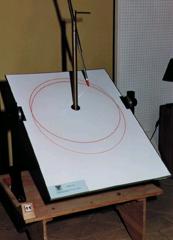
|
One can draw an ellipse using the great
three-dimensional compasses which the Arab geometers
had called the perfect compasses. The inclined
rod that rotates around the vertical axis describes a
cone, which is intersected by the drawing plane.
According to the latter's inclination, one can obtain a
circumference (if the plane is horizontal) or an ellipse,
longer the more inclined the plane. If one could increase
indefinitely the plane's inclination, one would obtain
first a parabola and then a hyperbole.
|
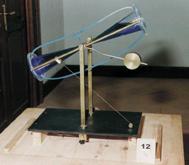
|
In the same way, depending on the machine's
inclination, the plane of the water, which is always
horizontal, intersects the water according to an ellipse,
a parabola or a hyperbole. A second cone, symmetrical to
the first, shows the two branches of the hyperbole.
|

|
Other elliptical compasses, some of which are
exhibited, can be built using the various properties of
this curve: one can also find them on sale. A parabola or
a hyperbole are more difficult to draw.
|
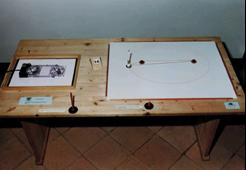
|
The simplest way to draw an ellipse is with a piece
of string, a bit like with the circumference we drew at
the start.
A circumference has all the points at the
same distance from the centre, so we can draw it with a
string, keeping one end fixed and rotating the other one
with a marker. When the circumference gets longer and
becomes an ellipse, the centre, so to say, divides up
into two points: the foci. These have a characteristic
property: if you take any point on the ellipse and you
unite them with the two foci, the sum of the lengths of
the two segments is always the same.
This property can be used to draw an ellipse on the
ground: fix two stakes on the foci and attach to them the
two ends of a string. If now we bring a pencil around so
that the string is always kept taut, the curve we have
drawn is an ellipse, called the gardener's ellipse,
because this method is often used to draw elliptical
flower beds.
|
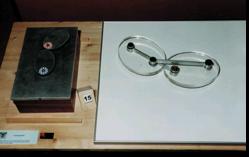
|
The same property can be used to build elliptical
gears. If you take to identical ellipses, dispose them so
that each of them can rotate around one of their foci,
and if the distance between the stakes is equal to the
length of the string that describes the ellipse, the two
ellipses always remain tangent, and the rotation of one
drags along the other. Moreover, if the first one rotates
uniformly, the second has a variable velocity, higher the
nearer the tangent point is to the fixed focus. If the
two ellipses are very oblong, while the first rotates in
24 hours, the second takes up almost all the time to go
half around, and goes the other half in a few minutes.
This phenomenon is used for date display mechanisms in
watches.
|
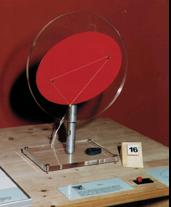
|
Another important property of the ellipse is that the
line perpendicular to the ellipse in any of its points
divides the angle formed by the string (that is, by the
lines that link the point to the foci) in two halves.
This property is relevant to light reflection. When a ray
of light reflects on a mirror, be it flat or curved, the
perpendicular to the mirror makes equal angles with both
the incident ray and with the reflected ray, that is,
with the incoming and the outgoing rays. But then, a ray
of light which starts from a focus behaves like the
string in the gardener's ellipse: after having reflected
on the ellipse, it will strike the other focus.
|
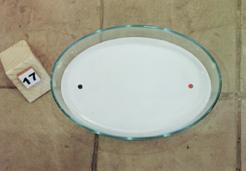
|
The same is true for any type of ray: light, sound,
heat. In every case, all the rays that originate from a
focus, after a reflection on the ellipse, will
concentrate in the other. This is the reason for the name
foci ("fires"): if one places a source
of heat on one of the foci, the heat concentrates in the
other and it can light up a piece of paper or an
inflammable material.
A simple kitchen pan (of an
approximately elliptical shape) with its bottom covered
in water can be used to illustrate the phenomenon. If you
touch the water with a finger on one of the foci (marked
by a dot on the bottom), you create concentric waves
that, after having reflected on the side of the pan,
concentrate on the other focus.
|
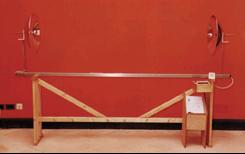 As the generating plane becomes more and
more inclined, the ellipsis becomes more and more oblong, and the
second focus moves away from the first. When it is transformed
into a parabola, the second focus disappears (sometimes one says
it has gone to infinite) and there is only one left. And while in
an elliptical mirror the rays originating from a focus ended up
in the other, in a parabolic mirror the rays that start from the
only remaining focus are reflected parallel to the axis, and
viceversa the rays parallel to the axis concentrate in the focus.
As the generating plane becomes more and
more inclined, the ellipsis becomes more and more oblong, and the
second focus moves away from the first. When it is transformed
into a parabola, the second focus disappears (sometimes one says
it has gone to infinite) and there is only one left. And while in
an elliptical mirror the rays originating from a focus ended up
in the other, in a parabolic mirror the rays that start from the
only remaining focus are reflected parallel to the axis, and
viceversa the rays parallel to the axis concentrate in the focus.
This latter property of the parabola can be used to build a
burning mirror, that is a mirror that concentrates solar rays
(which we may consider parallel because of the great distance of
the Sun) in the focus, where they can light up inflammable
materials. We have built an indoors burning mirror, substituting
solar rays with those from a halogen lamp. We have put the lamp
in the focus of a second parabolic mirror, from which the light
rays come out parallel after being reflected; a second reflection
on the first mirror concentrate them on the focus, where in a
short time they light up a match.
The same principle is at the base of the parabolic microphone:
the sound waves, which can be considered parallel if they come
from afar, are reflected on the parabola and concentrated on the
focus, where a microphone is places. This mechanism can hear very
far away and faint noises. The great radiotelescopes and the
parabolic dishes of satellite TV are also built using the focal
properties of the parabola.
Parabolas are often found as solutions of technical and
scientific problems. A stone thrown obliquely describes a
parabola, just as the cable of a suspension bridge also assumes
the shape of a parabola.
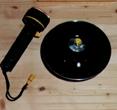
Using two identical parabolas we can create an interesting
phenomenon. What you see is a sort of black box in the shape of a
disc, with a flat hole on which a die is placed. You can light
this die with a torch, and at first sight it has all the
properties of a real object. But when you try to take or touch it,
you see that there is no die: it's an optical illusion.
This mirage has a simple explanation. The box is actually made
of two identical, superimposed parabolic mirrors, each of which
has its focus more or less in the other's vertex. On the bottom
of the lower mirror is the die, while the upper one has a hole
through which it is possible to see inside. When one looks
through this hole, or lights it up with a torch, the light ray
makes two reflections before hitting the die, thus forming a real
image of it, absolutely identical to the original.

|
In fact, burning mirrors and the mirage are made not
with parabolas, but with surfaces obtained rotating
parabolas around their axis. These surfaces are called
rotation paraboloids. A paraboloid can be obtained
rotating a liquid fast enough inside a cylindrical
container. If instead the liquid is contained between two
close planes, we have a parabola.
Similarly, when we
rotate an ellipse or a hyperbole, we obtain a rotation
ellissoid or hyperboloid.
|
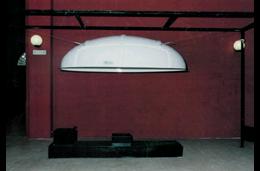
|
These surfaces also have reflecting properties
similar to the ones of the paraboloid. We have built an
elliptical chamber, obtained by rotating a half-ellipse
along the axis. A phenomenon similar to the burning
mirror happens in it: if we place ourselves in one of the
foci and we speak towards the elliptical wall, even in a
very low voice, those who are in the other focus receives
the voice very clearly, while whoever is in between hears
hardly anything.
|
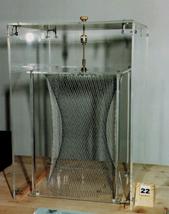
|
The rotation hyperboloid has the notable
characteristic of being a lined surface, that is of being
constituted only of straight lines, as we can see from
the hyperboloid obtained with strings.
|
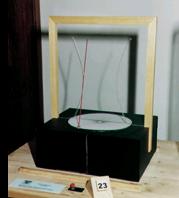
|
This produces an unexpected phenomenon: rotating a
straight line opportunely inclined, one can make it go
through a hyperbole-shaped slit. The rod, rotating,
describes a hyperboloid, which, intersected with a plane,
leaves us with the two slits through which the rod passes
with no difficulty.
|
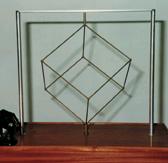

|
The same surface is obtained by rotating a cube.
While the upper and lower edges, that meet the rotation
axis, form a cone, the intermediate ones, which do not
meet the axis, generate a hyperboloid, which is visible
thanks to the persistence of images on the retina.
|
|
|
